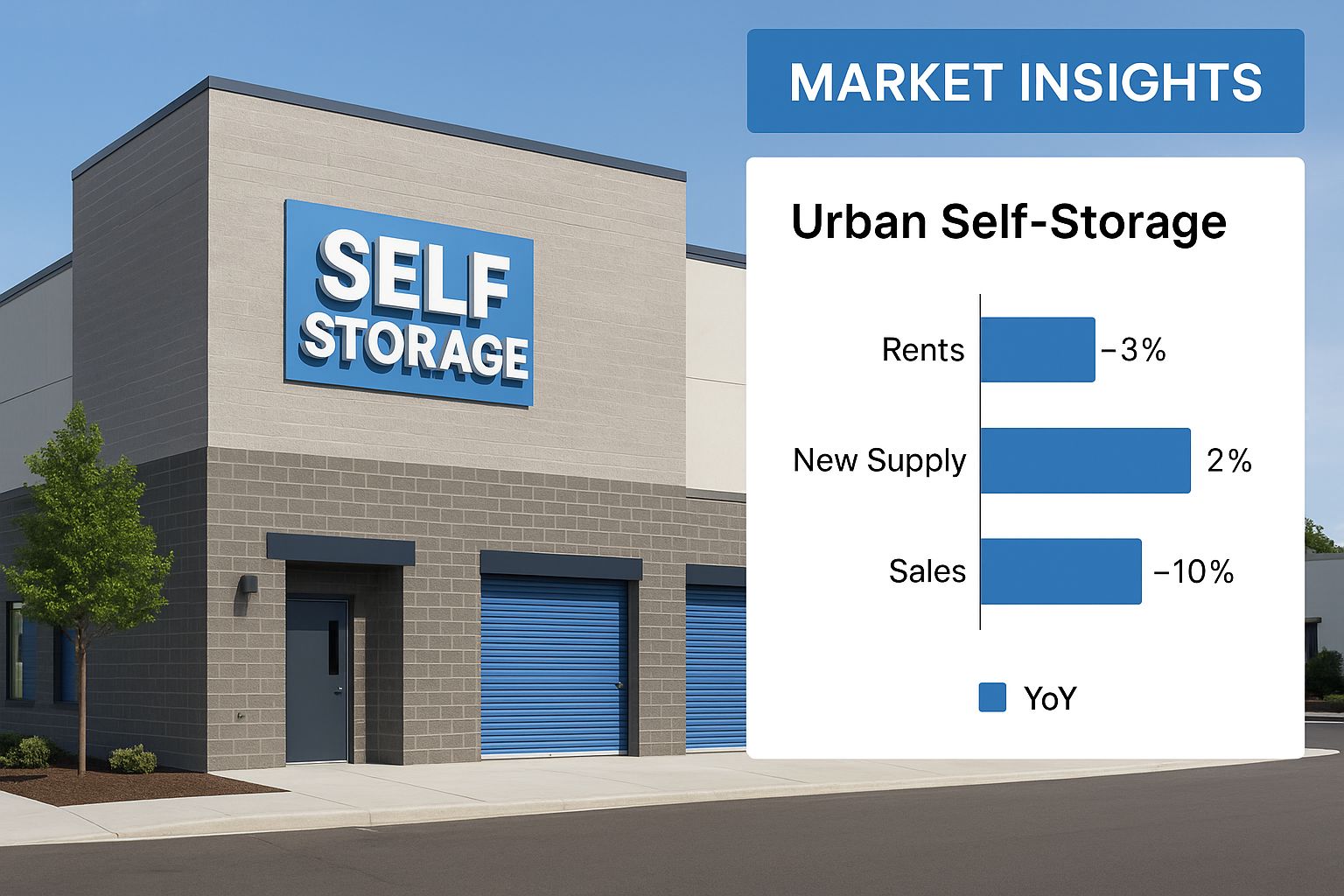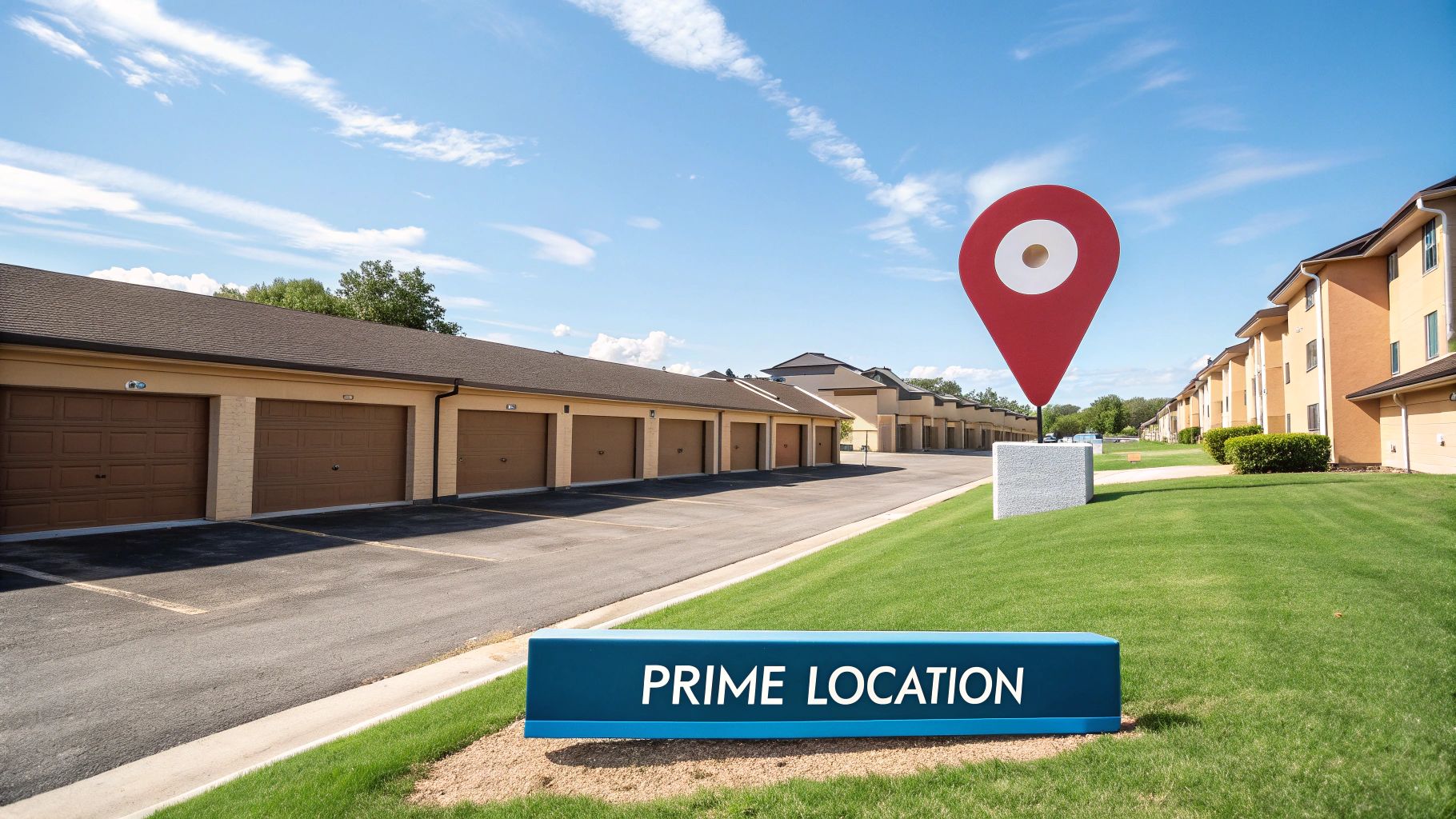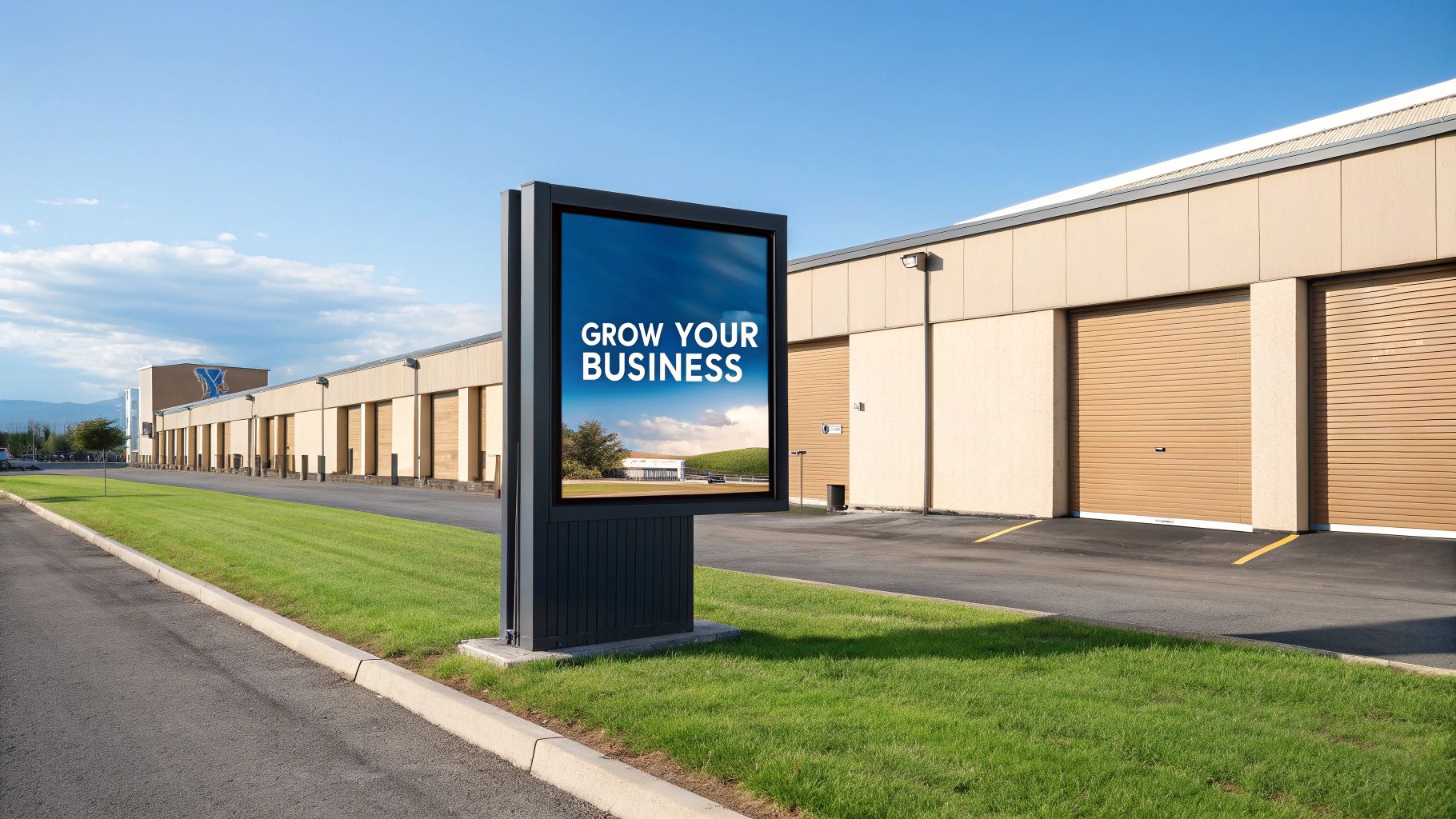Thinking about getting into the self storage business? It's a solid move. At its core, you're providing secure, rentable space for people and businesses, creating a steady monthly income from a physical property. But success isn't just about putting up a few units; it comes down to a great location, smart management, and really getting to grips with what your customers need.
Is Self Storage a Good Business Venture?
Diving into the self storage market is a big decision, and you need to understand the numbers before you jump in. This isn't just about renting out empty boxes. It's a dynamic property business with its own economic quirks, running costs, and customer types. The real appeal is its simple revenue model and how well it holds up when the economy gets shaky. When times are good, people buy more stuff and need somewhere to put it. When things get tough, life changes like downsizing or moving create just as much, if not more, demand for storage.
The industry is in great shape. The UK self storage market recently hit an impressive turnover of £1.2 billion. This is backed by around 2,915 facilities across the country, showing just how established and widespread the business is. If you want to dig deeper, you can learn more about the boom in container storage facilities from Cleveland Containers.
To give you a clearer picture, here's a quick look at the UK self storage market right now.
UK Self Storage Market at a Glance
| Metric | Figure |
|---|---|
| Annual Industry Turnover | £1.2 Billion |
| Total Number of Facilities | 2,915 |
| Total Rentable Space | 60.5 Million sq ft |
| Container-Based Sites | 1,135 |
| Average Net Rental Rate | £26.49 per sq ft/year |
These figures paint a picture of a healthy, growing industry. It’s not just surviving; it’s thriving, with plenty of room for new players who get the formula right.
Revenue Streams and Operational Costs
Your main income will obviously be the monthly rent from the units. But the savviest facilities don't stop there. Ancillary sales are where you can really boost your profits.
Think about adding these to your offering:
- Retail Sales: Selling essentials like locks, boxes, and packing tape on-site is a no-brainer.
- Insurance: Offering tenant insurance gives your customers peace of mind and earns you a nice commission.
- Late Fees: Nobody aims for them, but late fees are a reality of the business and they do add to the bottom line.
- Van Hire: Partnering with a rental firm or having your own branded van is another service that generates income and makes your customers' lives easier.
On the other side of the coin, you have your running costs, which are thankfully quite predictable. You'll be looking at property taxes, staff wages, insurance, utilities, marketing, and management software. A well-managed facility can expect to see operating margins between 40% and 60%, which makes self storage a very attractive option compared to other types of commercial property.
Choosing Your Business Model
Not all self storage sites are the same. The model you choose will depend heavily on your budget, vision, and where you plan to build. In the UK, two main formats dominate the scene, and each has its own pros and cons.
Traditional Multi-Storey Facilities
This is the classic image of self storage: a large building with internal corridors, climate-controlled units, and lifts to get between floors. They’re usually found in cities or busy suburbs and appeal to a wide range of customers, but the cost of land and construction is significantly higher.
Container-Based Storage
This model has absolutely exploded in popularity, especially in semi-rural spots where land is cheaper. It’s all about converting shipping containers into secure, drive-up units. The setup is quicker, more flexible, and requires less cash upfront. It’s a huge hit with customers who value easy access over extras like climate control. In fact, 1,135 of the UK's facilities are now container sites, which tells you everything you need to know about their rise.
The secret is to match the type of facility to your local market and your wallet. A container site could be perfect for an area with lots of tradespeople needing to store tools and equipment. A multi-storey building, on the other hand, is ideal near new housing estates or areas with a lot of renters.
Understanding Your Customer Base
Finally, if you want your self storage business to succeed, you need to know who you’re serving. Your customer base is far more varied than you might think.
- Residential Movers: These are your bread and butter. People moving house, downsizing, or doing a big renovation will always need storage.
- Small Businesses: E-commerce sellers storing stock, builders securing their tools, and offices archiving documents are a crucial, long-term source of revenue.
- Students: The need for storage over the summer holidays provides a reliable, seasonal spike in business.
- Life Events: People going through big life changes—like divorce, inheritance, or moving abroad—often need a temporary space for their belongings.
Getting your head around these different needs is the first step toward building a business that doesn't just get by, but genuinely flourishes.
Finding the Perfect Location for Your Facility
The old estate agent mantra of 'location, location, location' is more than a cliché in the self-storage world; it's the absolute foundation of your success. I’ve seen it time and again: a brilliant facility in the wrong place will struggle, while an average one in a prime spot can absolutely thrive. Pinpointing that perfect site means going far beyond a simple map search. You have to dig into the data that reveals real, unmet demand.
Think of yourself as a local detective, hunting for signs of growth and transition within a community. What you're really looking for are areas where people are actively in need of storage. Key indicators include rising population figures, high housing turnover, and a growing number of small businesses. These factors signal a dynamic area where people and companies are constantly experiencing life changes—the very changes that create a need for extra space.
Analysing Regional and Local Demand
First, let's look at the big picture. Market data shows that growth in the UK self-storage sector isn't happening uniformly across the country. It’s patchy, and you need to know where the hotspots are.
Regionally, the market shows uneven growth that lines up with population density and economic activity. The South East and North West of England are leading the charge in inventory expansions, with projected increases of 6.3% and 4.9%, respectively. Other strong contenders include the West Midlands (3.2%), East Midlands (2.8%), and the South West (2.1%). On the flip side, regions like London (1.2%) and Scotland (0.7%) are seeing much more modest growth.
This high-level view helps you narrow down promising counties or regions, but the real gold is in the local details. That’s where you’ll find your opportunity.
Start drilling down with these local data points:
- Population Density and Growth: Get your hands on data from the local council and the Office for National Statistics (ONS). A growing population, especially one with a high concentration of renters or people in smaller homes, is a massive green flag.
- Housing Market Activity: High rates of house sales and new developments mean people are on the move. And movers are, without a doubt, one of the biggest customer segments for self-storage.
- Business Density: Check local business directories and see what’s happening on the ground. A high number of small businesses, particularly e-commerce sellers or tradespeople, points to strong commercial demand for units.
This infographic gives you a great visual summary of how these key market insights come together.

As you can see, it's the combination of population trends, housing data, and a sharp eye on the competition that will lead you to a location with built-in demand.
Sizing Up the Competition
Once you've zeroed in on a promising area, it’s time for some old-fashioned reconnaissance. Don't just check your potential competitors' prices online. You need to get a feel for their business on a much deeper level to find the gaps you can exploit.
Get in your car and visit their sites in person. Is the facility clean and well-maintained? Is access easy and secure? Make a note of their opening hours, the unit sizes they offer, and the general state of the property. A tired-looking competitor with limited hours could be an easy target for a modern, 24/7 access facility.
A critical mistake new owners make is underestimating existing competitors. Just because a facility looks old doesn't mean it isn't full. Always try to gauge their occupancy levels—a full car park during peak hours is a good sign they're doing well, which proves market demand.
Your competitor analysis has to extend online, too. Read their Google reviews carefully. What are customers really complaining about? Common issues often revolve around poor customer service, unexpected price hikes, or security concerns. Every single negative review is a clue, telling you exactly how to build a better service and win their customers over.
Zoning Regulations and Site Practicalities
Finding the perfect plot of land is only half the battle; you also have to be allowed to build on it. Before you get too attached to a site, you must investigate local zoning and planning regulations. Your best bet is to look for land zoned for industrial or commercial use, as these are most likely to get the green light for self-storage development.
Once you’ve found a suitable plot, put it through a practical reality check:
- Visibility: Can your site be easily seen from a major road? High visibility is free marketing, pure and simple.
- Accessibility: How easy is it for customers to get in and out, especially with large vans or lorries? Poor access is a major turn-off.
- Site Layout: Does the plot's shape allow for an efficient layout of buildings and driveways? Awkwardly shaped plots can seriously reduce the number of units you can build, which directly hurts your potential revenue. To learn more, check out this essential guide to building the best self storage units.
Finally, whether you're buying or leasing the land, legal diligence is absolutely crucial. When you’re this close to identifying the perfect location, understanding the ins and outs of negotiating a commercial lease is paramount. This is what secures favourable terms and protects your investment for the long haul.
Navigating Planning, Design, and Construction

This is where your vision for a self-storage as a business venture starts to take shape. Turning an empty plot of land into a profitable asset is a complex but rewarding journey, involving careful planning, smart design, and diligent construction management. Getting these elements right is non-negotiable for long-term success.
The first major hurdle in the UK is securing planning permission. I know the process can feel daunting, but solid preparation is your greatest ally. At the end of the day, local councils just want to see a well-considered project that benefits the area without causing disruption.
Your application needs to clearly show how your facility will meet local demand, address traffic flow, and fit aesthetically within the surroundings. Working with an architect or a consultant who has experience with local councils can make a huge difference here—they know the specific nuances and requirements that need to be met.
Crafting a Profitable Unit Mix and Layout
Before a single shovel hits the dirt, you need a blueprint for profitability. That starts with designing the perfect unit mix—the variety of unit sizes you'll offer. This isn’t guesswork; it’s a strategic decision that should flow directly from your market research.
For instance, if your site is near a university, you'll likely need more small, locker-style units for students. A facility in a suburban area full of families, on the other hand, will see much higher demand for larger units—think 100 or 150 square feet—to accommodate furniture during a house move.
Your unit mix has to reflect the real needs of your target customers. A solid starting point usually includes:
- Small Units (25-50 sq ft): Perfect for students, renters, or people storing seasonal items.
- Medium Units (75-100 sq ft): Typically the most popular size, ideal for the contents of a one or two-bedroom flat.
- Large Units (150+ sq ft): Suited for families moving house or businesses needing to store inventory.
The site layout is just as crucial. You have to strike a balance between maximising rentable space and providing a seamless customer experience. Wide driveways for removal lorries, clear signage, and logical numbering are essential. A poorly designed layout leads to customer frustration and operational headaches you just don't need. To dig deeper into this, our detailed guide offers valuable insights into self-storage design and innovative layouts for maximum efficiency.
Traditional Builds vs Container Sites
A fundamental choice you’ll face early on is the type of construction. The two main paths offer distinct advantages and disadvantages, heavily influencing your initial investment and your entire operational model.
Traditional Construction
This involves building a permanent, multi-storey structure. It gives you far superior options for climate control and security, which appeals to a broader customer base—especially those storing sensitive items. The trade-off? The upfront cost and construction timeline are significantly greater.
Container-Based Sites
Using modified shipping containers has become an incredibly popular and cost-effective route to market. The speed of deployment is a massive advantage; you can be up and running in a fraction of the time. This model is perfect for sites where drive-up access is a key selling point, particularly for tradespeople and small businesses.
Choosing between these models often comes down to your location and capital. A tight city-centre plot might demand a multi-storey build to maximise its small footprint, whereas a larger, semi-rural site is perfectly suited for a phased container rollout.
Managing Construction and Security Integration
Once you’ve finalised a design, the focus shifts to bringing it to life. Vetting and selecting the right contractors is one of the most important decisions you will make. You need to find builders with proven experience in commercial or industrial projects, and always, always check their references thoroughly.
Throughout the construction phase, keeping a tight grip on your budget is absolutely critical. Unexpected costs are almost inevitable, so having a contingency fund of 10-15% of the total construction budget is a wise safety net. Regular site meetings with your contractor will help keep the project on track and let you address any issues before they escalate.
Finally, integrate security features right from the very beginning. Modern customers expect top-tier security, and this is not an area to cut corners. Your plan must include:
- Perimeter Fencing: A robust, anti-climb fence is your first line of defence.
- Automated Gate Access: Keypad or app-based systems that log every single entry and exit.
- High-Definition CCTV: Comprehensive camera coverage of all driveways, corridors, and entry points.
- Individually Alarmed Units: A premium feature that offers customers ultimate peace of mind and justifies higher rates.
Building these security measures into the initial construction is far more cost-effective than trying to retrofit them later on. It shows customers you’re serious about protecting their belongings from day one.
Funding Your Venture and Crafting Your Business Plan
With a solid location and a clear design in mind, you’ve reached what is arguably the most critical stage: securing the capital to bring your vision to life. This is where your self-storage concept meets the hard reality of finance. A meticulously crafted business plan isn’t just a formality; it's the master key that unlocks the funding you need to break ground.
Think of your business plan as the story of your future success, told with numbers and strategy. Lenders and investors have seen countless proposals. Yours has to stand out by being both ambitious and, more importantly, completely believable. You need to prove that you've not only had a good idea but that you've scrutinised every single detail of making it a profitable reality.
Building a Plan Lenders Want to Read
Forget generic templates. A compelling business plan is tailored to the unique aspects of your project. It needs to clearly articulate the opportunity you’ve found and exactly how you intend to capitalise on it. This document is your primary sales tool for proving your venture is a sound investment.
Your plan should have a few core components:
- Executive Summary: A punchy, powerful overview of the entire plan. Write this last, but always place it first.
- Company Description: Get into the specifics of your legal structure, mission, and the exact services you'll offer—container storage, climate-controlled units, dedicated business spaces, you name it.
- Market Analysis: This is where you present the hard data you’ve gathered. Show them the local demand, population growth, and housing turnover figures. Prove an underserved market exists.
- Competitive Analysis: Don't just list your competitors. Dig into their weaknesses—are their reviews terrible? Do they have limited hours? Do they lack modern features? Explain precisely how you'll exploit these gaps.
- Operational Plan: Map out your day-to-day management strategy. Who’s on staff? What software will you use? What are your security protocols?
- Marketing Strategy: Detail how you’ll attract those crucial first customers and hit your target lease-up rate.
Following this structure transforms your idea from a loose concept into a tangible, fundable project. If you're looking for a more in-depth guide, our overview on how to build a self storage business provides a detailed roadmap for this entire process.
Creating Believable Financial Projections
Get ready for some serious scrutiny here. This part of your plan has to be built on realistic assumptions grounded in solid market research. You need to map out your finances from day one right through to stable operation, which typically means forecasting for a five-year period.
These are the key financial statements you absolutely must include:
- Start-Up Cost Analysis: Itemise every single expense you can think of. Land acquisition, planning fees, construction, security systems, and your initial marketing budget all need to be on there.
- Profit and Loss (P&L) Forecast: Project your monthly revenue based on a conservative lease-up rate, factoring in rental income and any other sales. Then, subtract your operational costs to show a clear path to profitability.
- Cash Flow Projections: This shows the actual money moving in and out of the business. It’s vital for proving you can cover your expenses and loan repayments, especially in those lean early months.
Lenders are immediately suspicious of overly optimistic projections. A common mistake we see is people assuming a 90% occupancy rate within the first year. A far more realistic and defensible model shows a gradual lease-up over 18 to 36 months. It shows you understand the realities of the market.
Exploring Your Financing Options
With a robust business plan in hand, you can confidently start talking to potential lenders. The UK market has several avenues for funding a self-storage project, and each one is suited to different circumstances.
High-street banks are a common starting point. They often offer commercial mortgages that can cover a big chunk of the land and construction costs. The potential downside? They might not be familiar with the unique operational model of self-storage.
This is where specialist lenders really shine. These firms get the self-storage industry—they understand its strong cash flow and high asset value. They're often more flexible and can appreciate the nuances of a phased construction plan or a container-based model.
Other routes like joint ventures with experienced developers or seeking investment from angel investors are also worth exploring. These can be particularly good options if you're bringing a prime location to the table but lack the full capital required. No matter which path you choose, your business plan is your ticket to starting those conversations.
Launching Your Operations and Marketing Playbook

With your facility built and ready to go, the game changes. Your focus pivots entirely to operations and marketing. Getting the doors open is the starting line, not the finish. Your long-term success in the self storage as a business world hinges on two things: running a tight ship and executing a relentless marketing plan to keep those units full.
The days of tracking everything on a spreadsheet are long gone. Modern self-storage facilities run on powerful software that handles nearly every part of the business. This is the engine room of your entire operation, so picking the right system is one of the most important decisions you'll make.
Streamlining Operations with Technology
Your facility management software (FMS) will quickly become your most valuable tool. It's designed to automate all the repetitive, time-sucking tasks that can easily bog down a small team. Think of it as your digital facility manager, handling everything from collecting rent and sending invoices to controlling who gets through the gate.
A good FMS can completely transform your customer experience. You'll want to look for platforms that give customers an online portal where they can check their accounts, pay their bills, and even sign rental agreements from their own sofa. This isn't just a nice-to-have feature anymore; it's what modern consumers expect, and it dramatically cuts down on your admin workload.
Adopting technology is a huge driver of efficiency in the UK storage sector. It’s not just about software; innovation is changing the game for customer service and facility management. For example, roughly 68% of UK self storage businesses are now using artificial intelligence tools in their operations. This tech-forward approach is what allows many facilities to run lean, with an average workforce of just 2.6 staff members per site.
Building Your Marketing Engine From Scratch
Now for the fun part: getting customers through the door. Your marketing shouldn't be a scattergun approach; it needs to be a well-oiled machine, with both digital and traditional parts working in harmony. To make sure your business attracts a steady flow of renters from day one, you have to implement proven customer acquisition strategies as a core part of your playbook.
For most customers today, the journey starts with a Google search—usually something specific and urgent like "storage units near me." If you don't show up, you might as well not exist.
Here's where you need to focus your initial efforts:
- Local SEO: This is absolutely non-negotiable. Kick things off by creating and meticulously optimising a Google Business Profile. Fill out every single section with high-quality photos, accurate opening hours, and your precise address. Gently encourage your first happy customers to leave reviews, as those positive ratings are a massive factor in local search rankings.
- A Professional Website: Your website has to be clean, mobile-friendly, and dead simple to navigate. Most importantly, it should allow customers to see available unit sizes, view pricing, and—ideally—reserve or rent a unit right then and there.
- Paid Advertising (Google Ads): While your organic search presence is building up, Google Ads can deliver immediate results. Target keywords with local intent, like "self storage in [Your Town]", to capture people who are actively looking to rent right now.
To give you a clearer picture, here's a breakdown of the essential channels you'll be using to find those first critical tenants.
Essential Marketing Channels for a New Storage Facility
| Marketing Channel | Primary Goal | Target Audience |
|---|---|---|
| Google Business Profile | Build local visibility and trust | People searching "storage near me" |
| Professional Website | Convert visitors into renters | Anyone researching storage options |
| Google Ads | Generate immediate, high-intent leads | Active searchers ready to rent now |
| Local Partnerships | Create a steady referral stream | People in life transition (moving, renovating) |
| On-Site Signage | Capture local drive-by traffic | Residents and businesses in the immediate area |
Each of these channels plays a specific role. Your digital presence casts a wide net, while your local efforts build deep community roots. Together, they create a powerful system for attracting customers.
You can’t just rely on the internet. Old-school, local marketing is still incredibly effective for self-storage. It’s all about building relationships within the community you serve.
Forging Powerful Local Partnerships
Think about who interacts with people right at the moment they realise they need storage. These are your ideal partners, and building genuine relationships with them can create a powerful referral network that costs you nothing but a bit of time.
Start by introducing yourself to these key local players:
- Estate Agents: They work with people moving house every single day. Drop off some high-quality brochures and maybe even offer a small referral fee or a special discount for their clients.
- Removal Companies: These guys are your natural allies. A good relationship here can lead to a steady stream of customers who need temporary storage during a move.
- Local Tradespeople: Plumbers, electricians, and builders often need a secure base to store tools and materials. They can become excellent, long-term tenants.
When you combine a strong digital foundation with these on-the-ground relationships, you create a complete system for attracting and keeping customers. This two-pronged approach ensures you're visible wherever your potential renters are looking—whether that's on their phone or in their local neighbourhood. It’s this complete playbook that turns an empty facility into a thriving, profitable business.
Frequently Asked Questions About the Self Storage Business
Thinking about diving into the self storage business? It’s a smart move, but like any venture, it comes with its fair share of questions. Here, we tackle some of the most common queries we hear from aspiring facility owners, using our real-world experience to give you the straight answers.
How Much Does It Realistically Cost to Start?
This is the big one, and the honest answer is: it varies dramatically. The final bill really comes down to land prices and the type of facility you want to build.
A modest container-based site on cheaper land might get off the ground in the low six figures. On the flip side, a purpose-built, multi-storey facility in a prime urban or suburban spot will almost certainly run into the millions.
Your single biggest expense, nearly every time, is the land itself. Don't forget to also budget for:
- Planning and legal fees
- Construction and materials
- Security technology (CCTV, access control)
- Management software
- A solid marketing budget to get the word out at launch
What Is a Realistic Timeframe to Reach Profitability?
Profitability all comes down to your 'lease-up' rate—how quickly you can fill those units. A well-placed, smartly marketed facility should aim for a stable occupancy of 85-90% within 18 to 36 months.
You'll likely hit your break-even point much sooner, often within the first couple of years. That’s the point where your monthly revenue consistently covers your operational costs and any loan repayments. A clever way to speed this up is with phased construction. Build an initial block of units, and only add more as demand starts to fill them. It’s a fantastic way to manage your cash flow.
A common pitfall for newcomers is underestimating the ongoing challenges of facility management. It's not just about filling units; it's about keeping them full and running the site efficiently day-to-day. You can explore some essential self storage facility management techniques for 2025 to get ahead of the curve.
What Are the Biggest Ongoing Challenges?
Once you're up and running, your primary challenges will be keeping occupancy high against local competition, handling routine property maintenance, and maintaining top-notch security.
Another constant hurdle is dealing with late payments and, occasionally, abandoned units. This isn't just a hassle; it requires you to follow strict legal procedures, so having a clear process from day one is vital. To stay competitive, you also need to adapt to what customers want, like offering climate-controlled options or more flexible access hours—all while keeping your costs lean through smart staffing and technology.
Is the UK Self Storage Market Becoming Oversaturated?
It’s more complex than a simple yes or no. While you’ll find fierce competition in major city centres, there are still countless secondary towns and growing suburban areas that are significantly underserved.
Your success hinges on doing a detailed, hyper-local market analysis. Don’t just look at the nearest city; look at the next town over. The continued rise of container storage also opens up opportunities in areas where traditional construction just isn’t financially viable. There's still plenty of room for new players, especially if you can offer a better customer experience or cater to a specific niche, like dedicated storage for students or local businesses.
Ready to turn your plans into a profitable reality? The expert team at Partitioning Services Limited has over two decades of experience in designing, manufacturing, and installing high-quality self-storage solutions across the UK. Learn how we can help you build your facility from the ground up by visiting us at https://psllimited.co.uk.
Looking for help with your next project?
Whether you are new to self storage or already have an established self storage facility, we can provide you with guidance and a full quotation for any aspect of your works.

